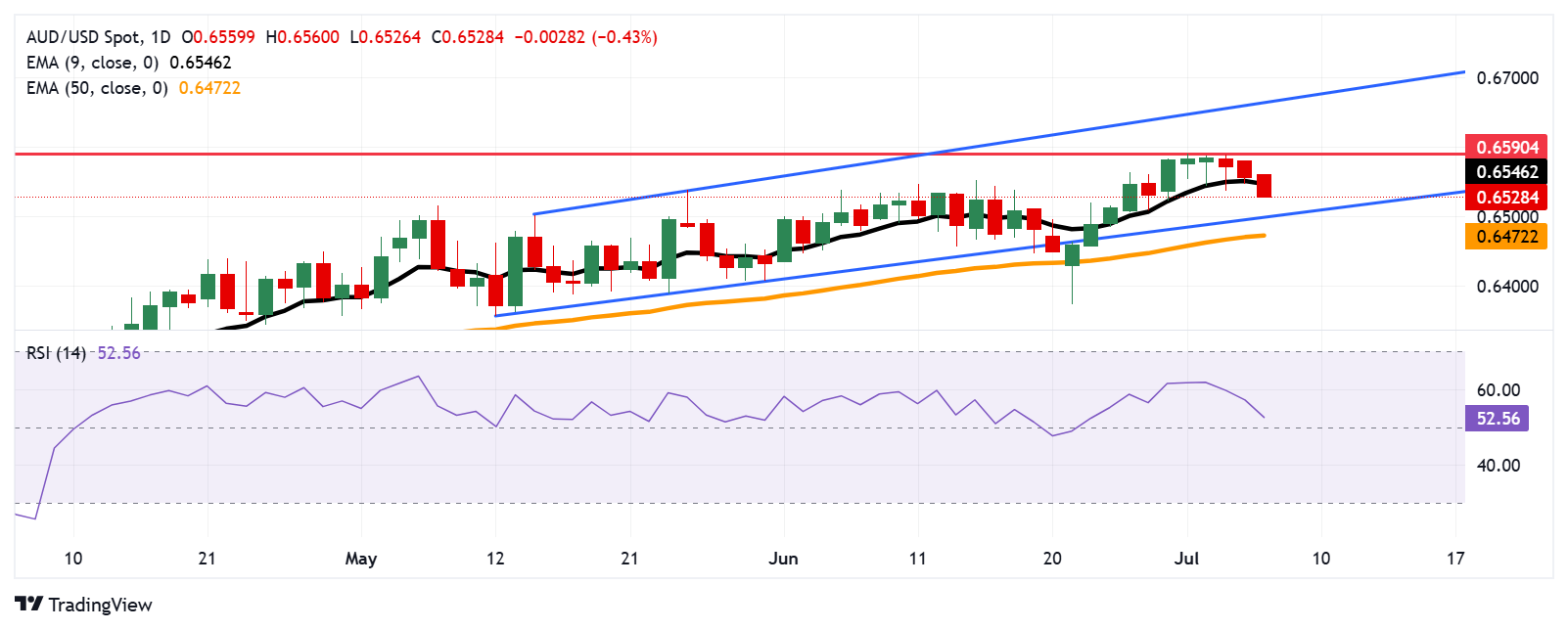Created
: 2025.07.07














![]() 2025.07.07 11:07
2025.07.07 11:07
The Australian Dollar (AUD) loses ground against the US Dollar (USD) on Monday, continuing its losing streak for the third successive session. The AUD/USD pair depreciates due to renewed tariff concerns as US President Donald Trump may send out 12 or 15 letters on tariffs later in the day, with expecting that trade deals or letters with most nations will be done by July 9.
ANZ Job Advertisements increased by 1.8% in June after a decline of 1.2% in May. The data presents the number of job advertisements in the major metropolitan newspapers and on the internet sites in Australia.
The Financial Times reported that China is increasingly rerouting its exports through Southeast Asia in an effort to dodge US tariffs imposed by the Trump administration. Data indicates that direct shipments from China to the US dropped by 43% in May, even as China's overall exports rose by 4.8%. This shift was marked by a 15% surge in exports to Southeast Asia and a 12% increase to the European Union (EU). However, the US trade agreement with Vietnam now includes a 40% tariff on trans-shipped goods to curb such practices. Any change in Chinese economy could impact the AUD as China and Australia are close trading partners.
Traders will focus on the Reserve Bank of Australia's (RBA) monetary policy meeting on Tuesday. The latest Reuters poll indicated that 31 out of 37 economists expect the RBA to deliver a quarter basis point rate cut in July. The median forecast now sees the cash rate falling to 3.10% by the end of 2025, down from 3.35% in the May survey.
The AUD/USD pair is trading around 0.6530 on Monday. Daily chart's technical analysis indicated a persistent bullish bias as the pair remains within the ascending channel pattern. The 14-day Relative Strength Index (RSI) is positioned slightly above the 50 mark, suggesting the bullish sentiment is prevailing. However, the pair has moved below the nine-day Exponential Moving Average (EMA), suggesting that short-term price momentum is weakening.
The AUD/USD pair may test the primary barrier at the nine-day EMA of 0.6546. A break above this level could improve the price momentum and support the pair to approach the eight-month high of 0.6590, recorded on July 1. Further advances would support the pair to explore the region around the upper boundary of the ascending channel around 0.6670.
On the downside, the AUD/USD pair may navigate the area around the ascending channel's lower boundary around 0.6500, followed by the 50-day EMA at 0.6472.

The table below shows the percentage change of Australian Dollar (AUD) against listed major currencies today. Australian Dollar was the weakest against the Swiss Franc.
| USD | EUR | GBP | JPY | CAD | AUD | NZD | CHF | |
|---|---|---|---|---|---|---|---|---|
| USD | 0.08% | 0.16% | 0.27% | 0.14% | 0.48% | 0.45% | 0.08% | |
| EUR | -0.08% | 0.08% | -0.05% | 0.02% | 0.44% | 0.35% | -0.03% | |
| GBP | -0.16% | -0.08% | -0.16% | -0.04% | 0.37% | 0.28% | -0.23% | |
| JPY | -0.27% | 0.05% | 0.16% | 0.10% | 0.42% | 0.40% | -0.14% | |
| CAD | -0.14% | -0.02% | 0.04% | -0.10% | 0.36% | 0.33% | -0.19% | |
| AUD | -0.48% | -0.44% | -0.37% | -0.42% | -0.36% | 0.01% | -0.59% | |
| NZD | -0.45% | -0.35% | -0.28% | -0.40% | -0.33% | -0.01% | -0.51% | |
| CHF | -0.08% | 0.03% | 0.23% | 0.14% | 0.19% | 0.59% | 0.51% |
The heat map shows percentage changes of major currencies against each other. The base currency is picked from the left column, while the quote currency is picked from the top row. For example, if you pick the Australian Dollar from the left column and move along the horizontal line to the US Dollar, the percentage change displayed in the box will represent AUD (base)/USD (quote).
One of the most significant factors for the Australian Dollar (AUD) is the level of interest rates set by the Reserve Bank of Australia (RBA). Because Australia is a resource-rich country another key driver is the price of its biggest export, Iron Ore. The health of the Chinese economy, its largest trading partner, is a factor, as well as inflation in Australia, its growth rate and Trade Balance. Market sentiment - whether investors are taking on more risky assets (risk-on) or seeking safe-havens (risk-off) - is also a factor, with risk-on positive for AUD.
The Reserve Bank of Australia (RBA) influences the Australian Dollar (AUD) by setting the level of interest rates that Australian banks can lend to each other. This influences the level of interest rates in the economy as a whole. The main goal of the RBA is to maintain a stable inflation rate of 2-3% by adjusting interest rates up or down. Relatively high interest rates compared to other major central banks support the AUD, and the opposite for relatively low. The RBA can also use quantitative easing and tightening to influence credit conditions, with the former AUD-negative and the latter AUD-positive.
China is Australia's largest trading partner so the health of the Chinese economy is a major influence on the value of the Australian Dollar (AUD). When the Chinese economy is doing well it purchases more raw materials, goods and services from Australia, lifting demand for the AUD, and pushing up its value. The opposite is the case when the Chinese economy is not growing as fast as expected. Positive or negative surprises in Chinese growth data, therefore, often have a direct impact on the Australian Dollar and its pairs.
Iron Ore is Australia's largest export, accounting for $118 billion a year according to data from 2021, with China as its primary destination. The price of Iron Ore, therefore, can be a driver of the Australian Dollar. Generally, if the price of Iron Ore rises, AUD also goes up, as aggregate demand for the currency increases. The opposite is the case if the price of Iron Ore falls. Higher Iron Ore prices also tend to result in a greater likelihood of a positive Trade Balance for Australia, which is also positive of the AUD.
The Trade Balance, which is the difference between what a country earns from its exports versus what it pays for its imports, is another factor that can influence the value of the Australian Dollar. If Australia produces highly sought after exports, then its currency will gain in value purely from the surplus demand created from foreign buyers seeking to purchase its exports versus what it spends to purchase imports. Therefore, a positive net Trade Balance strengthens the AUD, with the opposite effect if the Trade Balance is negative.
![]()
Created
: 2025.07.07
![]()
Last updated
: 2025.07.07

FXStreet is a forex information website, delivering market analysis and news articles 24/7.
It features a number of articles contributed by well-known analysts, in addition to the ones by its editorial team.
Founded in 2000 by Francesc Riverola, a Spanish economist, it has grown to become a world-renowned information website.
We hope you find this article useful. Any comments or suggestions will be greatly appreciated.
We are also looking for writers with extensive experience in forex and crypto to join us.
please contact us at [email protected].
Disclaimer:
All information and content provided on this website is provided for informational purposes only and is not intended to solicit any investment. Although all efforts are made in order to ensure that the information is correct, no guarantee is provided for the accuracy of any content on this website. Any decision made shall be the responsibility of the investor and Myforex does not take any responsibility whatsoever regarding the use of any information provided herein.
The content provided on this website belongs to Myforex and, where stated, the relevant licensors. All rights are reserved by Myforex and the relevant licensors, and no content of this website, whether in full or in part, shall be copied or displayed elsewhere without the explicit written permission of the relevant copyright holder. If you wish to use any part of the content provided on this website, please ensure that you contact Myforex.
Myforex uses cookies to improve the convenience and functionality of this website. This website may include cookies not only by us but also by third parties (advertisers, log analysts, etc.) for the purpose of tracking the activities of users. Cookie policy